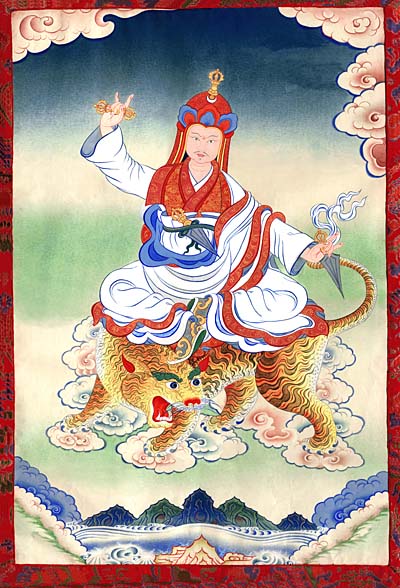
dro phang lingpa
visionary discoverer of the khordong gTérmas
Khandro Déchen says of this thangka:
This beautiful visionary image is painted in a spacious style which I try to emulate. It depicts a great master of the gö-kar chang-lo’i dé as a lineage holder of the Nyingma Tradition. The
colours are unusually vivid and portray the dynamism of the white-skirted long-haired tradition of Vajrayana Buddhism. The original thangka is kept in Wales as a fine example of ngak’phang imagery and a treasure of the Confederate Sanghas of Aro.
The incarnation line of Nuden Dorje Dro’phang Lingpa Tröllö-tsal begins with the first Nuden Dorje who was a disciple of the Buddha Rinchen Nyingpo. Rinchen Nyingpo was the previous enlightened embodiment of Buddha Shakyamuni. In the current time-cycle, Nuden Dorje first took rebirth as Shariputra, the foremost disciple of Buddha Shakyamuni. He then took rebirth as:
1. Dorje Hung-dzé, one of the eight great mahasiddhas.
2. Do-wang Khyéchung Lotsa, one of the twenty-five closest disciples of Padmasambhava.
Khandro Déchen comments:
He received many transmissions from Padmasambhava at Chhimphu, Thamdrug, and Zhi-trö Dé-dro in the company of
Yeshé Tsogyel. He remained close to Padmasambhava all the time he was in Tibet right up to Padmasambhava’s departure into other dimensions. Khyéchung Lotsa was a mahasiddha and had the power to attract birds by mudras. By this means he was able to teach beings at many levels of existence the nature of reality and enable them to achieve
realization.
Nuden Dorje next took rebirth as:
3. Gyalwa Thöndup – the principal pupil of Ma-gÇig Labdrön, the famous female Lama and enlightened master who originated the practice of gÇod.
4. Namgyal Gönpo – the son of Rig’dzin Go’dem-founder of the Chang gTér, The Northern gTérmas.
5. Drüpchen Sang-gyé Palzang.
6. Drüpchen Tong-chö Répa.
7. Drüpchen Bum-pa.
8. gTértön Chenpo Düd’dül Dorje.
9. Taksham Nuden Dorje – of whom Ngak’chang Rinpoche comments:
Taksham Nuden Dorje also appears in the incarnation line of
Dorje Tröllö – the Lama Dorje Tröllö Kyi Namthar (bLa ma rDo rJe gro lod kyi rNam thar). Taksham Nuden Dorje was regarded as a zhig-po – a wisdom-eccentric or enlightened meschuggenah.
In the 19th Century the incarnation line bifurcated again. These two incarnations were Nuden Dorje Dro’phang Lingpa Tröllö-tsal of the ’ö-Chung clan of Nyi-khok; and Düd’jom Lingpa of the A-Kyong clan who lived near the Kokonor Lake in Northern Tibet. These Lamas were both mahasiddhas who taught profusely and were powerful in their influence. Nuden Dorje Dro’phang Lingpa Tröllö-tsal discovered twenty-three volumes of gTérma, and other gTérma of different types. He discovered both a vajra and phurba – the implements which embody the Energy of Dorje Tröllö. He also discovered the amazing Do-dom Thong-ba Ton-den, a gTérma casket made of stone which is almost two feet in circumference. This box carries the impressions left by the hands of Yeshé Tsogyel and Padmasambhava. This incarnation had extraordinary magical powers – he could fly, remain below water or become invisible to the eye. He lived to the age of 63 and on the day of his death a great rainbow appeared in the sky emanating from the hill where he died. The second incarnation was Dro’dul Dorje, who died at the age of 5. The third incarnation, Khalden Lingpa, was the teacher of ’a-Shul Pema Legden who became the disciple and sangyab of Khyungchen Aro Lingma. Khalden Lingpa discovered two important volumes of gTérma and a gTérma casket, and lived to the age of 37.
Ngakpa ’ö-Dzin Tridral comments:
The incarnation of Khalden Lingpa is known as Zilngön Lingpa. He is perhaps better known as
Chhi’mèd Rig’dzin Rinpoche (Khordong gTérchen Tulku Chhi’mèd Rig’dzin Rinpoche), although many people remember him as CR Lama from his days as the Head of Indo-Tibetan Studies at the Visvabharati University of West
Bengal.
Nuden Dorje Dro’phang Lingpa Tröllö-tsal built a number of important gompas according to the instruction of Padmasambhava, and according to the predictions of both the Great Fifth Dala’i Lama and Rig’dzin Pema Thrinlé Rinpoche. His pupils built twelve other gompas in Eastern Tibet.
